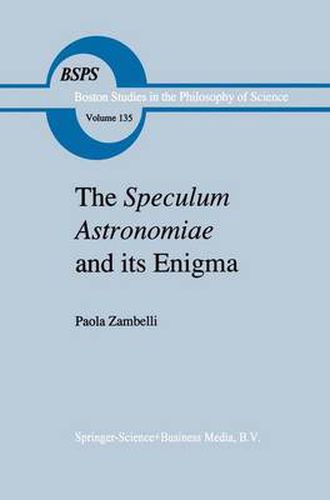Readings Newsletter
Become a Readings Member to make your shopping experience even easier.
Sign in or sign up for free!
You’re not far away from qualifying for FREE standard shipping within Australia
You’ve qualified for FREE standard shipping within Australia
The cart is loading…






This title is printed to order. This book may have been self-published. If so, we cannot guarantee the quality of the content. In the main most books will have gone through the editing process however some may not. We therefore suggest that you be aware of this before ordering this book. If in doubt check either the author or publisher’s details as we are unable to accept any returns unless they are faulty. Please contact us if you have any questions.
The attribution of the Speculum Astronomiae to Albertus Magnus became a controversial issue only recently, when the neo-Thomist historian Pierre Mandonnet suggested - without any antecedents - that the author was Roger Bacon. Madonnet’s theses werre refuted by Lynn Thorndike and have since then been the subject of widespread discussion. This historiographical case study considers this debate in the light of an analysis of texts by Albert himself, as well as other important authors, such as Bacon, Bonaventura, Thomas Aquinas, Witelo, Campanus of Novara, and others, which shows how widespread the general concept of the influence of the stars and other astrological ideas to be found in the Speculum were. Most of the scientific ideas of the Middle Ages were based on principles derived from the notion of celestial influence and its consequences. The Speculum drew the fundamental outlines of this discipline into a theoretical and bibliographical introduction and was consequently greeted with a great interest and used as a standard reference book for many centuries. Set against the background of discussions taking the place in thw 1260s, within the Dominican Order as well as in the Faculties of Arts, Zambelli makes a strong case for the Speculum being written by Albert, possibly with some collaboration.
$9.00 standard shipping within Australia
FREE standard shipping within Australia for orders over $100.00
Express & International shipping calculated at checkout
Stock availability can be subject to change without notice. We recommend calling the shop or contacting our online team to check availability of low stock items. Please see our Shopping Online page for more details.
This title is printed to order. This book may have been self-published. If so, we cannot guarantee the quality of the content. In the main most books will have gone through the editing process however some may not. We therefore suggest that you be aware of this before ordering this book. If in doubt check either the author or publisher’s details as we are unable to accept any returns unless they are faulty. Please contact us if you have any questions.
The attribution of the Speculum Astronomiae to Albertus Magnus became a controversial issue only recently, when the neo-Thomist historian Pierre Mandonnet suggested - without any antecedents - that the author was Roger Bacon. Madonnet’s theses werre refuted by Lynn Thorndike and have since then been the subject of widespread discussion. This historiographical case study considers this debate in the light of an analysis of texts by Albert himself, as well as other important authors, such as Bacon, Bonaventura, Thomas Aquinas, Witelo, Campanus of Novara, and others, which shows how widespread the general concept of the influence of the stars and other astrological ideas to be found in the Speculum were. Most of the scientific ideas of the Middle Ages were based on principles derived from the notion of celestial influence and its consequences. The Speculum drew the fundamental outlines of this discipline into a theoretical and bibliographical introduction and was consequently greeted with a great interest and used as a standard reference book for many centuries. Set against the background of discussions taking the place in thw 1260s, within the Dominican Order as well as in the Faculties of Arts, Zambelli makes a strong case for the Speculum being written by Albert, possibly with some collaboration.